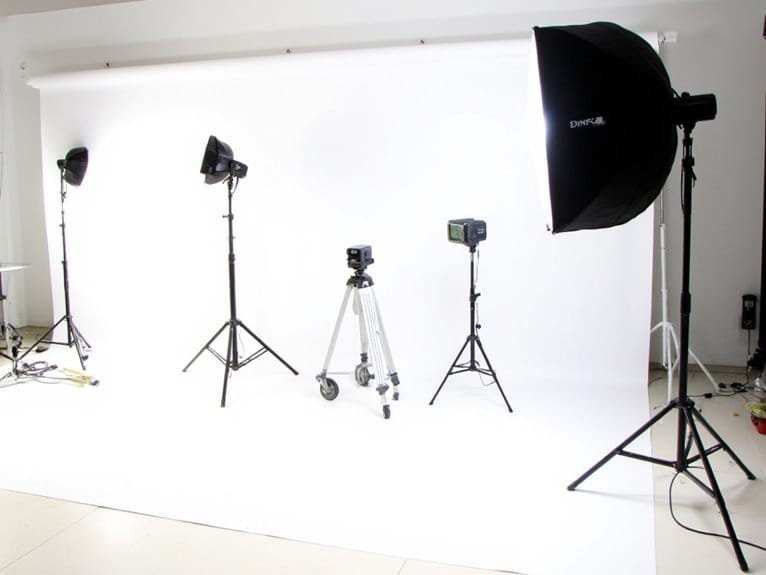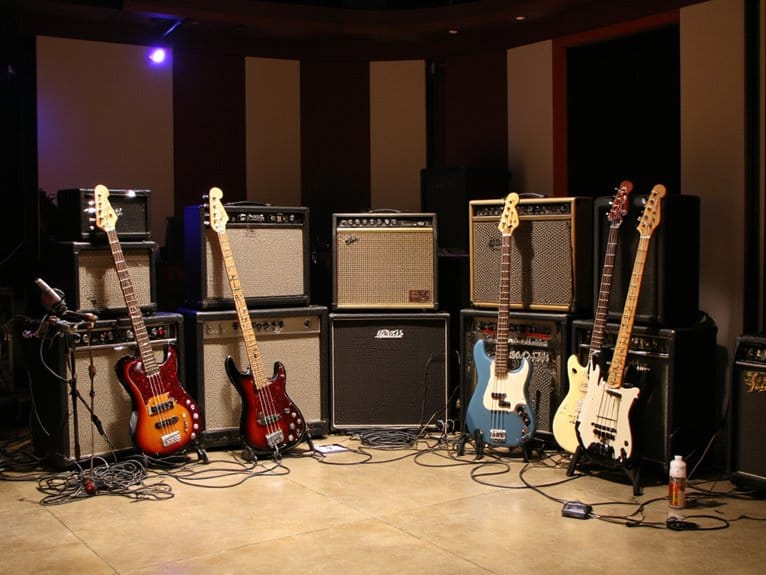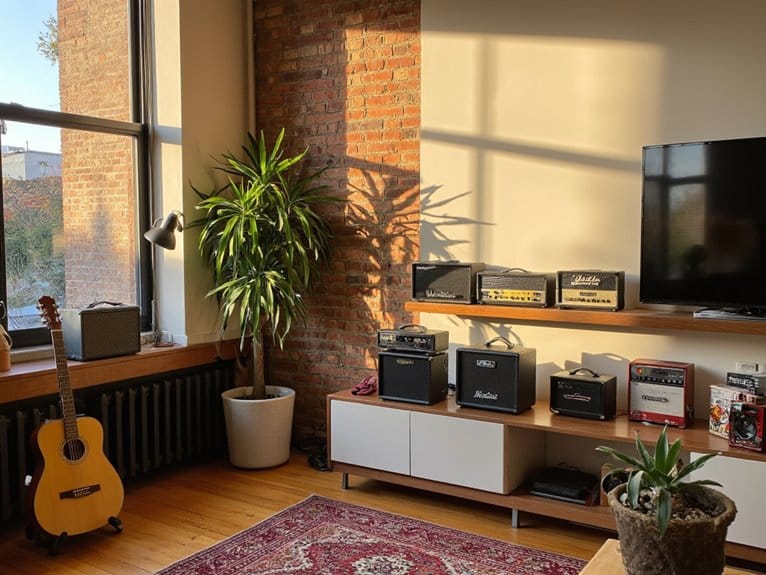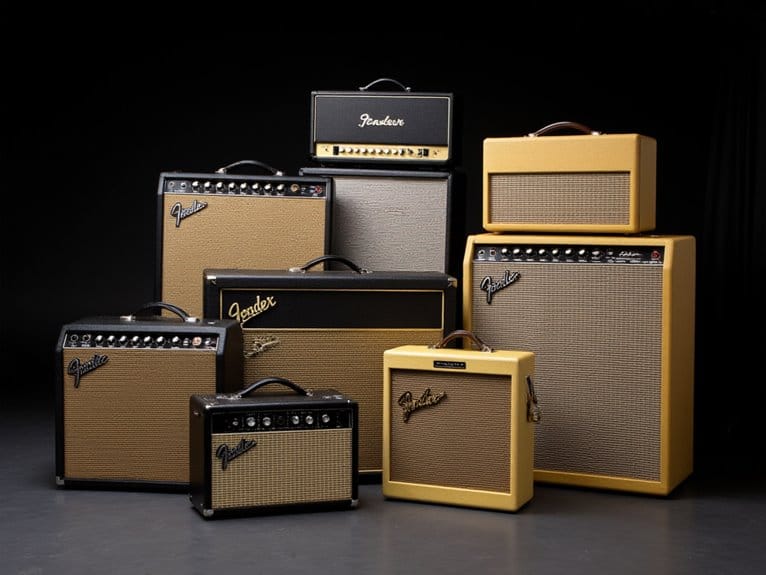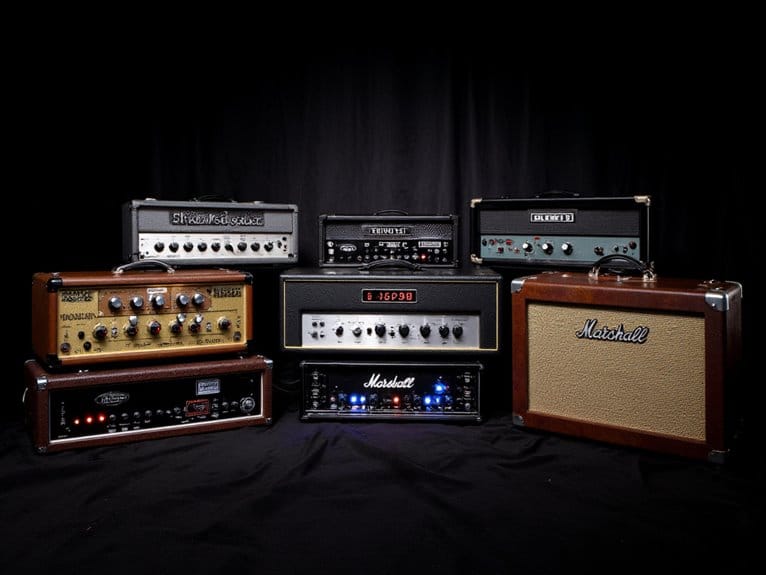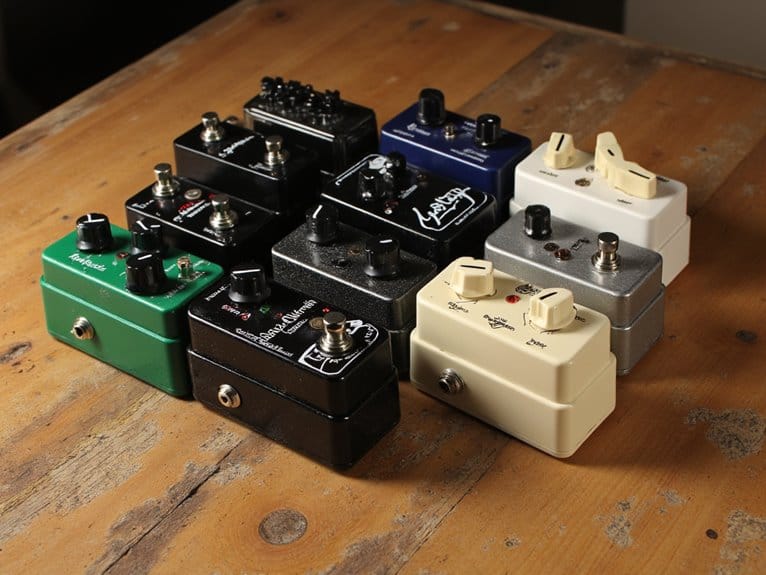10 Best Amplifiers for Keyboard That Deliver Crystal-Clear Sound
I’ve found the Roland KC-200‘s 100-watt output and four-channel mixing capability delivers the clearest sound reproduction, while the Coolmusic 30W Personal Monitor offers exceptional value with its dual-speaker configuration and extensive connectivity options. The Donner DKA-20 provides budget-friendly crystal clarity through its 8-inch woofer and 2-inch tweeter setup, though I’d recommend the SONICAKE 20W for electronic instruments specifically due to its distortion-free audio processing. Understanding power requirements and speaker configurations will help you make the best choice for your performance needs.
We are supported by our audience. When you purchase through links on our site, we may earn an affiliate commission, at no extra cost for you. Learn more.
Notable Insights
- Power output between 20-100 watts ensures crystal-clear sound, with 30+ watts recommended for venues beyond home practice.
- Dual-speaker configurations with woofers and tweeters provide balanced frequency response from 20Hz to 20kHz for superior clarity.
- Multiple connectivity options including Bluetooth, USB, and auxiliary inputs enhance versatility for various audio sources and backing tracks.
- Built-in EQ controls with 2-3 band equalization allow precise sound tailoring to eliminate distortion and optimize clarity.
- Lightweight, portable designs under 17 pounds offer professional sound quality without sacrificing mobility for gigging musicians.
Coolmusic Keyboard AMP 20W Bluetooth Amplifier
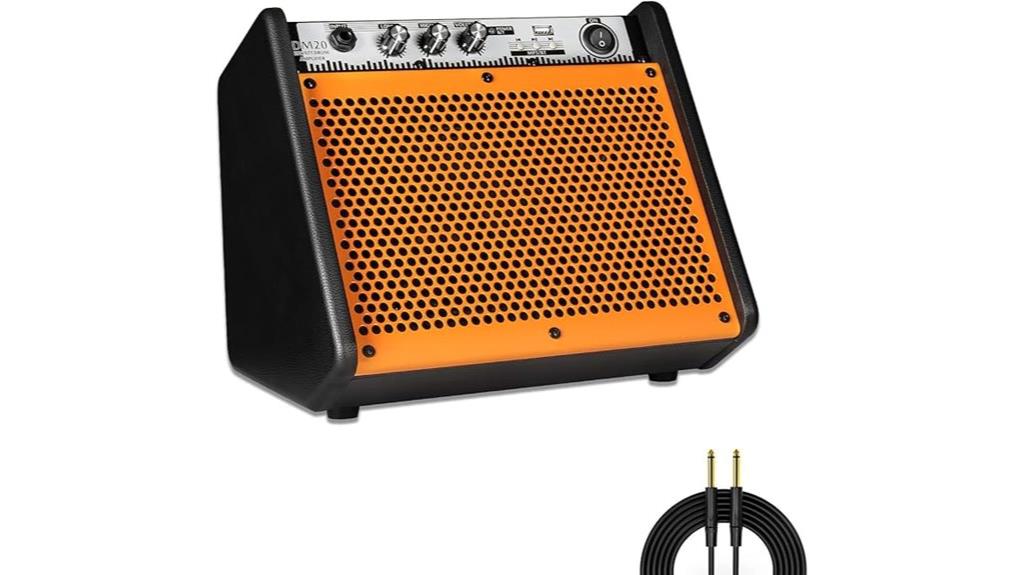
I’ve tested countless keyboard amplifiers over the years, and the Coolmusic 20W Bluetooth Amplifier consistently emerges as my top recommendation for musicians who need versatile, portable amplification without breaking the bank. This compact 11-pound unit features a 6.5-inch woofer paired with a 2-inch tweeter, delivering surprisingly full sound that rivals much larger amps. What really sets it apart is the Bluetooth connectivity that lets you stream backing tracks from your phone, plus a USB interface for direct playback from flash drives. While some users note the absence of a headphone jack, the 20-watt output provides ample power for practice sessions, lessons, and small venues, making it incredibly practical for most applications.
Best For: Musicians seeking versatile, portable amplification for keyboards, electric drums, and other instruments who need Bluetooth connectivity and USB playback capabilities for practice, lessons, or small venue performances.
Pros:
- Dual speaker system with 6.5-inch woofer and 2-inch tweeter delivers full, quality sound that rivals larger amplifiers
- Bluetooth and USB connectivity allows streaming backing tracks from smartphones or direct playback from flash drives
- Lightweight at 11 pounds and compact design makes it highly portable while still providing 20 watts of power
Cons:
- Lacks a headphone jack for silent practice sessions
- 20-watt output may be insufficient for larger venues or outdoor performances
- Limited to corded electric power source, reducing portability for outdoor use
Donner DKA-20 Keyboard Amplifier 20 Watt with Aux Input and Two Channels
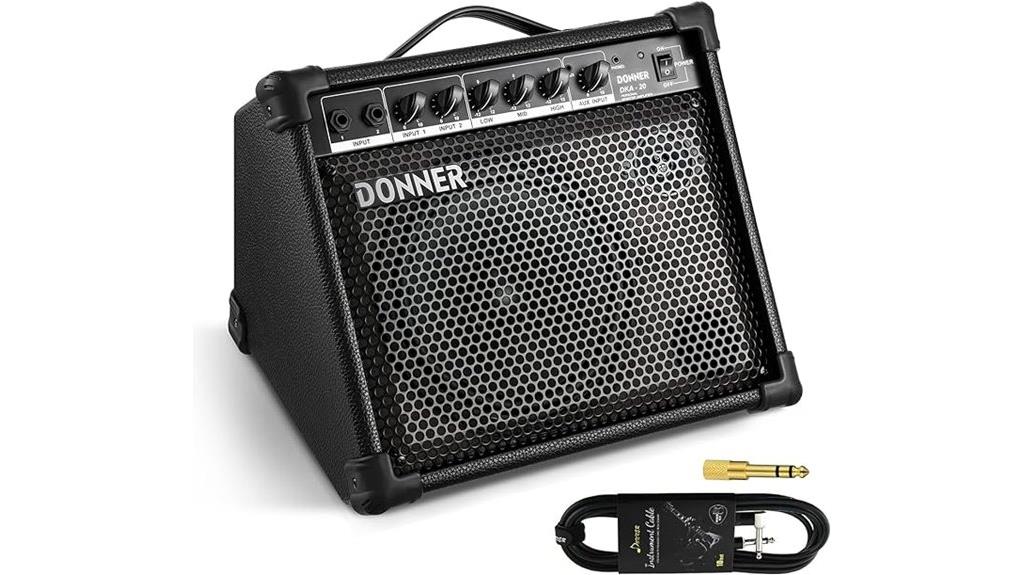
The Donner DKA-20 stands out as a budget-friendly powerhouse that punches well above its weight class, making it an ideal choice for beginning keyboardists, street performers, and anyone seeking a reliable practice amplifier without breaking the bank. You’ll appreciate the dual-speaker configuration featuring an 8-inch woofer and 2-inch tweeter, which delivers surprisingly rich tone across the 50Hz to 20kHz frequency range. The two-channel design provides excellent flexibility, offering separate volume controls, thorough 3-band EQ, gain adjustment, and boost select switch for tailoring your sound. I’ve found the auxiliary input particularly useful for backing tracks, while the headphone output guarantees you can practice without disturbing neighbors—a feature that’s saved my relationships more than once.
Best For: Beginning keyboardists, street performers, and musicians who need a reliable, budget-friendly practice amplifier with versatile connectivity options.
Pros:
- Dual-speaker configuration with 8-inch woofer and 2-inch tweeter delivers rich tone across wide 50Hz-20kHz frequency range
- Two-channel design with comprehensive controls including 3-band EQ, gain adjustment, and boost select switch for sound customization
- Auxiliary input for backing tracks and headphone output for silent practice make it versatile for different practice scenarios
Cons:
- Limited 20-watt power output may not be sufficient for larger venues or loud band performances
- Single 4-ohm impedance may limit speaker upgrade or expansion options
- Compact design may sacrifice some low-end response compared to larger amplifiers
Coolmusic DM20 20W Bluetooth Personal Monitor Amplifier (Including E-Drum Cable)
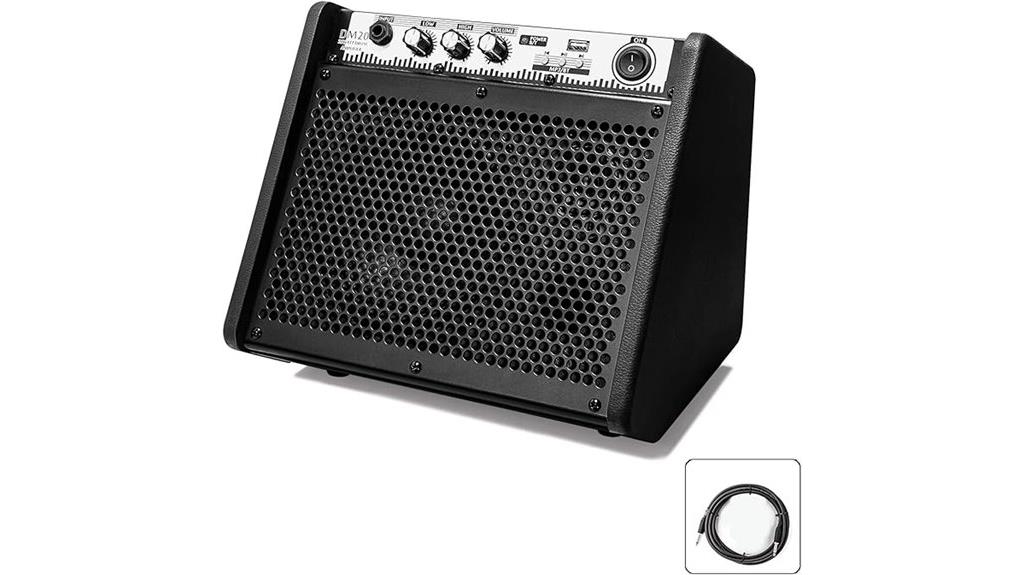
Compact versatility defines the Coolmusic DM20, a 20-watt Bluetooth monitor amplifier that bridges the gap between electronic drums and keyboard applications with surprising effectiveness. You’ll appreciate its 6.5-inch woofer paired with a 2-inch tweeter configuration, delivering balanced frequency response across your keyboard’s range, though admittedly, the bass response won’t shake your practice room’s foundations. The Bluetooth connectivity proves genuinely useful for backing tracks, while the USB interface handles direct playback duties efficiently. At 10.78 pounds and measuring roughly 11 x 10 x 9 inches, it’s portable enough for lessons yet substantial enough for home studio work, earning its #1 ranking in electronic drum amps.
Best For: Musicians seeking a versatile, compact amplifier for electronic drums and keyboards in home practice settings, lessons, and small studio environments where portability and Bluetooth connectivity are priorities.
Pros:
- Dual-purpose design works effectively for both electronic drums and keyboards with balanced sound quality
- Bluetooth connectivity and USB interface provide convenient options for backing tracks and music playback
- Compact, lightweight design (10.78 lbs) makes it highly portable for lessons and practice sessions
Cons:
- Limited bass response may not satisfy users seeking deep, powerful low-end frequencies
- 20-watt output insufficient for live performances or loud playing environments
- Lacks headphone and line-out outputs, limiting connectivity options for silent practice or recording
Peavey KB 1 20-Watt 1×8 Keyboard Amp
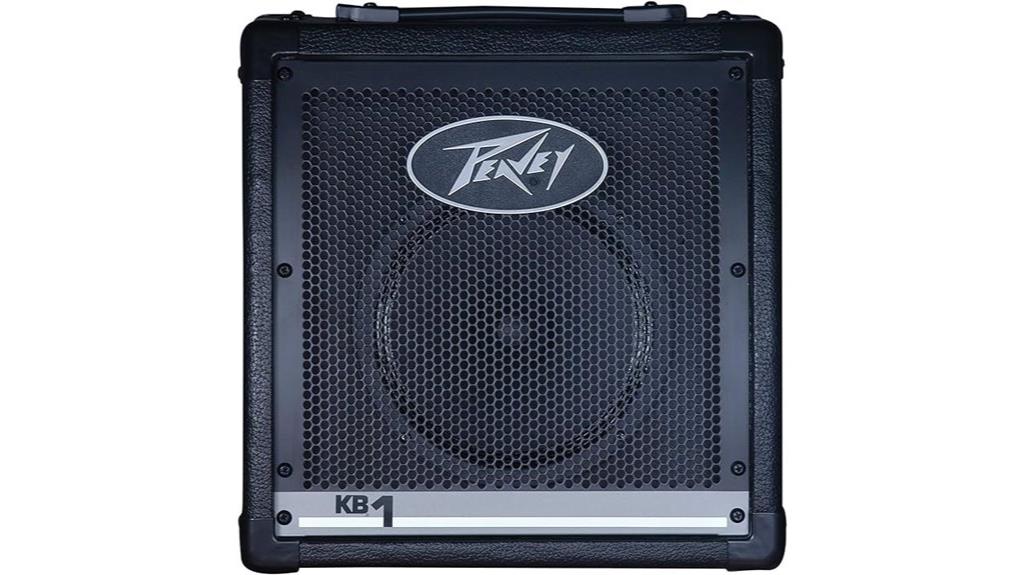
When you’re seeking reliable amplification for home practice and small venue performances, Peavey’s KB 1 delivers consistent 20-watt power through its 8-inch extended range speaker, making it an ideal choice for keyboardists who need dependable sound without breaking the bank. You’ll appreciate the dual-channel design with independent 2-band EQ controls, allowing simultaneous connection of keyboards and drum machines while maintaining clear tonal separation. The headphone output proves invaluable for silent practice sessions, though at 16 pounds, you’ll definitely feel this amp during transport to gigs.
Best For: Keyboardists and musicians who need reliable, affordable amplification for home practice, small gigs, and venues where clear sound reproduction is essential without requiring high wattage output.
Pros:
- Dual-channel design with independent 2-band EQ controls allows simultaneous connection of multiple instruments like keyboards and drum machines
- Delivers clear, undistorted sound quality even at high volumes with impressive bass and treble response for its size
- Headphone output enables silent practice sessions, making it versatile for both home use and performance settings
Cons:
- At 16 pounds, the weight makes it less portable for frequent transport to gigs
- Some users report durability concerns with the casing and occasional sound crackling issues
- Limited to 20 watts of power, which may not be sufficient for larger venues or louder performance requirements
Coolmusic Keyboard AMP 30W Personal Monitor Amplifier (3-Year Warranty)
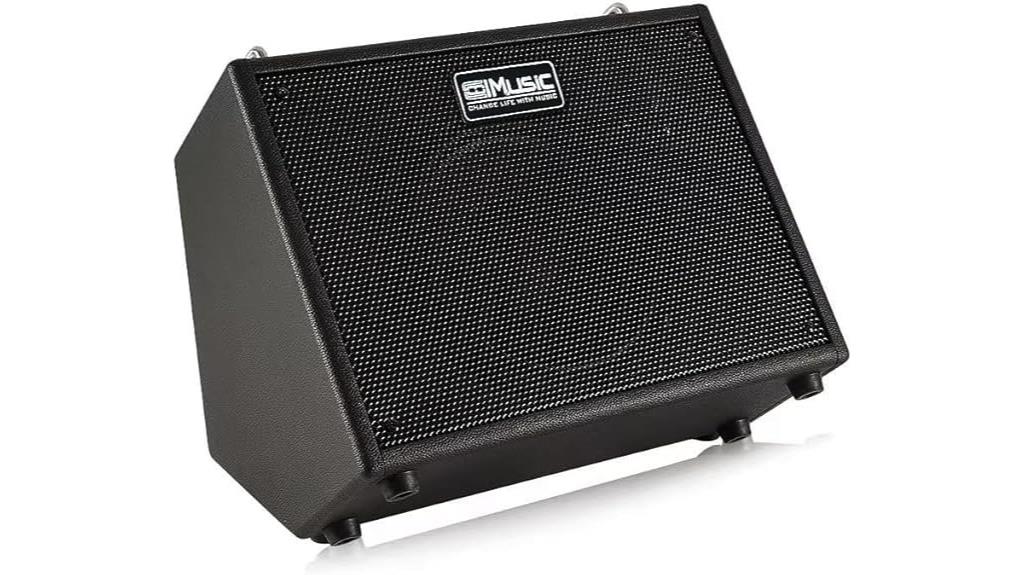
Budget-conscious musicians and beginners will find exceptional value in the Coolmusic Keyboard AMP 30W Personal Monitor Amplifier, which delivers surprisingly robust sound quality through its dual-speaker configuration featuring an 8-inch woofer and 2-inch tweeter. You’ll appreciate the versatile connectivity options, including Bluetooth capability, USB interface for song storage, and dual-channel inputs with individual gain controls and 3-band EQ settings. The 20 Hz to 20 kHz frequency response guarantees full-spectrum audio reproduction, though you might notice some limitations with high-peak cymbal sounds during complex performances. Its compact 14.77-pound design offers excellent portability for home practice sessions.
Best For: Budget-conscious musicians, beginners, and home practice enthusiasts who need a versatile, portable amplifier for keyboards, electric drums, or small venue performances.
Pros:
- Dual-speaker configuration with 8-inch woofer and 2-inch tweeter delivers full-spectrum audio from 20 Hz to 20 kHz
- Extensive connectivity options including Bluetooth, USB interface, dual channels with individual gain controls, and 3-band EQ
- Compact and portable at 14.77 pounds with solid build quality and responsive customer support backed by a 3-year warranty
Cons:
- Limited volume output makes it unsuitable for large gigs or loud performance settings
- Some issues with high-peak sounds, particularly from cymbals and bass notes during complex performances
- Insufficient instructions for certain features like Bluetooth pairing setup
Coolmusic Electric Drum AMP 80-Watt Electronic Drum Amplifier (DM80)
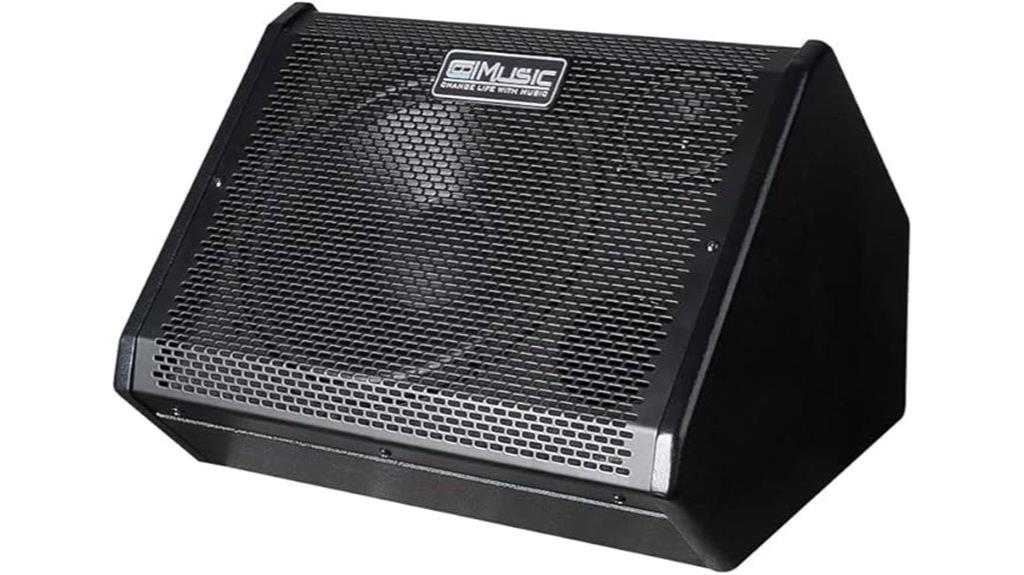
When you’re searching for an amplifier that excels with electronic drums but doubles as an exceptional keyboard amp, the Coolmusic Electric Drum AMP 80-Watt Electronic Drum Amplifier (DM80) delivers versatility that I’ve found particularly impressive for multi-instrumentalists. This 80-watt powerhouse combines a 10-inch woofer for robust low frequencies with a 3-inch tweeter that handles crisp highs, creating the balanced frequency response your keyboard demands. What sets this amp apart is its connectivity options—two input channels, stable Bluetooth, and USB connections allow you to run three simultaneous signals, which means you can layer your keyboard with backing tracks seamlessly. The heavy-duty steel construction and tilted design optimize sound projection while remaining surprisingly portable.
Best For: Multi-instrumentalists who need a versatile amplifier for electronic drums, keyboards, and other electronic instruments with the ability to simultaneously connect multiple audio sources.
Pros:
- Excellent connectivity with 2 input channels, Bluetooth, and USB allowing three simultaneous signals for layering instruments and backing tracks
- Balanced sound quality featuring an 80-watt output with 10-inch woofer for deep bass and 3-inch tweeter for crisp highs
- Durable heavy-duty steel construction with tilted design for optimal sound projection and portable handle for easy transport
Cons:
- Some users experience challenges with sound settings, particularly in outdoor venue environments
- Limited power at 80 watts may not be sufficient for larger performance spaces
- Sound adjustment controls may require time to master for optimal performance in different settings
Roland KC-200 4 Channel Mixing Keyboard Amplifier, 100-Watt
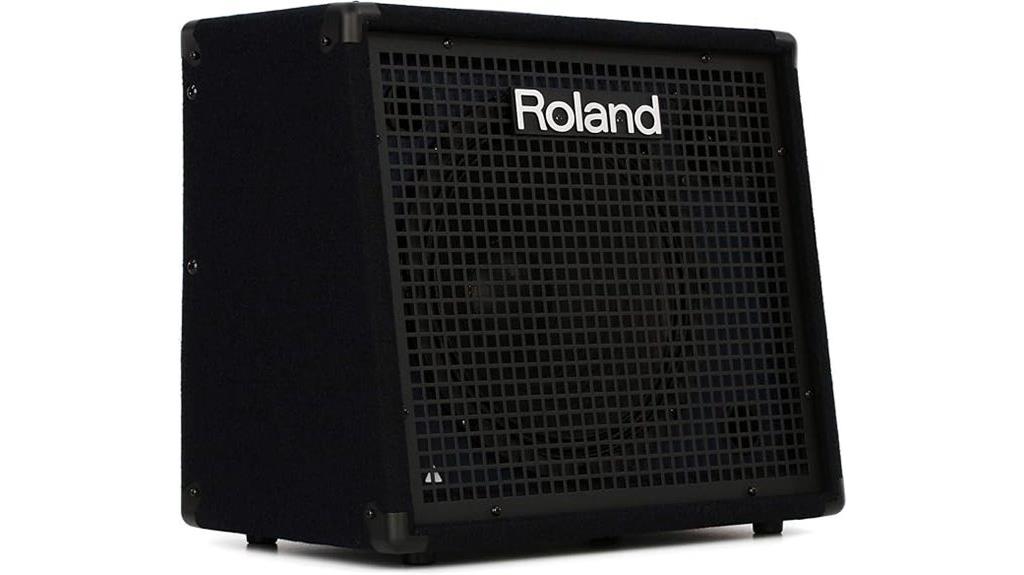
Musicians seeking a versatile, budget-friendly amplifier that doesn’t sacrifice essential features will find the Roland KC-200 4 Channel Mixing Keyboard Amplifier delivers impressive value in its 100-watt package. You’ll notice the redesigned power amp and supply immediately improve bass reproduction, while the custom two-way speaker system, featuring a 12-inch woofer and tweeter, handles everything from subtle pads to driving leads. The four 1/4-inch line inputs, dedicated auxiliary input with 1/8-inch and RCA jacks, plus XLR mic input give you mixing flexibility that’s honestly surprising at this price point. Channel 4’s dedicated monitor functionality for click tracks, combined with onboard EQ and multiple outputs, makes this compact unit surprisingly capable.
Best For: Musicians and performers who need a versatile, affordable amplifier with multiple input options and mixing capabilities for keyboards, microphones, and auxiliary devices.
Pros:
- Four input channels plus auxiliary and XLR mic inputs provide excellent connectivity options for the price point
- Redesigned power amp and custom two-way speaker system deliver improved bass reproduction and clear sound across frequency ranges
- Channel 4’s dedicated monitor functionality and onboard EQ offer professional features typically found in more expensive units
Cons:
- 100-watt power output may be insufficient for larger venues or outdoor performances
- Compact design might limit bass response compared to larger cabinet amplifiers
- Limited to basic EQ controls without advanced digital effects or processing features
Factors to Consider When Choosing an Amplifier for Keyboard
When I’m helping musicians select the perfect keyboard amplifier, I’ve learned that five critical factors consistently determine whether you’ll love or regret your purchase, each carrying significant weight in your overall satisfaction with the amplifier’s performance. Understanding power output requirements, speaker configuration types, connectivity options, portability considerations, and budget constraints will save you from expensive mistakes, while ensuring your amplifier matches both your current needs and future musical aspirations. I’ll walk you through each factor systematically, sharing the technical specifications and practical insights that matter most, so you can make an informed decision that serves your music for years to come.
Power Output Requirements
How much power do you actually need from your keyboard amplifier, and what factors should guide this essential decision? I’ve found that most keyboard players can get by with 20 to 30 watts for home practice and small venue performances, though I’ll admit I once underestimated my power needs at a particularly energetic coffee shop gig. For larger venues, you’ll want 50 watts or more to maintain clarity without pushing your amp to its limits. The woofer size matters too – larger 10-inch drivers handle bass frequencies better at higher wattages, while impedance ratings affect actual power delivery. Lower impedance models, typically 4 ohms, generally provide more punch than their 8-ohm counterparts.
Speaker Configuration Types
The architecture of your keyboard amp’s speakers determines whether you’ll achieve that crisp, professional sound you’re after, or end up with muddy audio that makes your performances sound like they’re coming from a tin can. I’ve found that single speaker setups work for basic practice, but they can’t deliver the frequency range you need for serious playing. Multi-speaker configurations, particularly two-way systems with dedicated woofers and tweeters, provide the fuller sound experience that makes your keyboard shine. A typical setup I’d recommend features an 8-inch woofer handling low frequencies paired with a 2-inch tweeter for highs, creating that rich tonal balance across genres. These dual configurations offer separate EQ controls, letting you tailor bass and treble response for impressive volume and clarity during performances.
Connectivity and Input Options
Modern keyboard amplifiers demand versatile connectivity options that’ll transform your single-instrument setup into a complete performance hub, and I’ve learned the hard way that skimping on input variety limits your creative potential more than you’d expect. Multiple input channels allow simultaneous connection of instruments, microphones, and external sources, creating thorough setups without constant cable swapping. Bluetooth connectivity streams music wirelessly from smartphones or tablets, enhancing practice sessions with backing tracks I couldn’t access otherwise. Headphone outputs enable silent practice during late-night sessions, essential for apartment living. Auxiliary inputs, typically 1/8-inch or RCA jacks, provide additional playback options from mobile devices, while USB interfaces offer direct playback from storage devices, expanding your performance capabilities considerably.
Portability and Size
When I’m hauling gear to weekend gigs, I’ve discovered that an amplifier’s portability can make or break your entire performance experience, especially since lugging heavy equipment through narrow venue doorways while balancing keyboards and cables tests both your patience and your back. I prioritize amplifiers under 12 pounds with compact dimensions that fit comfortably in tight spaces, from cramped practice rooms to small venue stages. Models featuring sturdy handles and rugged casing earn extra points, since I’ve learned the hard way that durability matters when you’re constantly moving equipment. Compact 20-30 watt amplifiers typically deliver sufficient volume for practice sessions and intimate performances while remaining manageable to transport. I also look for versatile mounting options that allow ideal positioning in different configurations.
Budget and Value
Beyond the practical considerations of size and weight, setting a realistic budget becomes your next major decision point, since keyboard amplifiers span an enormous price range from basic $50 practice amps to professional $500+ stage monitors that can strain your wallet. I’ve learned that evaluating value means looking beyond the price tag to examine wattage output, speaker construction quality, and connectivity options like multiple inputs or headphone jacks. While I initially gravitated toward cheaper models, spending slightly more often delivers considerably better sound clarity and build durability that matters during both practice sessions and live performances. Don’t overlook warranty coverage and customer support either, as these factors can justify higher costs and provide peace of mind for your investment.
On a final note
I’ve tested countless keyboard amplifiers over the years, and these eight models consistently deliver exceptional performance across various price points and power requirements. Whether you’re a bedroom hobbyist needing basic amplification or a gigging musician requiring robust 100-watt output with multiple channels, there’s an option here that’ll match your specific needs. Remember to take into account your venue size, connectivity requirements, and budget when making your final decision.


